Students will participate in activities that help them understand how historians take different pieces of a puzzle and put them together to learn about the past.
Students will be able to:
- locate on a map where the Maya lived and trace a route from their home state to the regions of Southern Mexico, Guatemala, Belize, and the northern part of El Salvador;
- identify the century in which the Maya Stela was made;
- calculate how long ago the Maya Stela was made;
- use Internet and printed sources to gather information; and
- work well with others in a group.
Lesson
- Preparation: Read the "Details" tab in the About the Art section for the Maya Stela. Prepare information sheets for the students, with only one piece of information about the Maya Stela on each sheet. Prepare your Internet access or other resources.
- Warm-up: Have students work with their group members to quickly build the simple puzzle. Talk about how to work in a group, sharing responsibilities and being polite. Tell them that today they are going to be working on a much more challenging puzzle–a puzzle from the past.
- Staying in their groups, tell the students that each group is going to receive one piece of a puzzle. Based on the information they receive, the members of the group have to come up with a hypothesis about the larger object that their clue is describing. Make sure one of the groups has information about the date for the Stela.
- Some of the groups will not be learning about the Stela but rather about the region from which it comes–exploring its climate, plants, or animals. For these groups, have them write a hypothesis about why they are learning about this information.
- After the groups have had sufficient time to complete the task, ask them to write their hypotheses on the board. Read the hypotheses aloud.
- Show students the full image of the Stela and ask them which hypotheses were closest to the actual object. Why? Which groups were the furthest away? Why? What information was the most helpful when trying to solve the larger puzzle?
- Show them on Google Earth or a map where the Maya lived, tracing a route from their home states to the region. Allow the groups that researched the climate, plants, and animals to share their information. Identify images on the Stela that reflect this information.
- Share that historians build history from pieces of puzzles and that sometimes the information they have is helpful, and other times it can even be misleading. There are some questions that we will never be able to answer. Even historians don’t always get information correct, and it’s important to use multiple sources or pieces of data when trying figure out what something means.
- Allow time to practice locating the Yucatan Peninsula and Central America on a map, tracing a route from their home state to the region.
Materials
- One simple puzzle for every 3-4 students
- Information on the Maya civilization and the Stela printed onto separate sheets (i.e. one piece of information per sheet), one sheet for every 3-4 students
- Access to the Internet or other sources with information on the climate, plants, and animals of the Yucatan Peninsula and Central America
- Access to and a way to display images from Google Earth, or world maps on which you can trace a route from the students’ home state to the Yucatan Peninsula and Central America
- About the Art sheet on the Maya Stela (found at the end of the lesson plan)
- Color copies of the Maya Stela for students to share, or the ability to project the image onto a wall or screen
Standards
- Social Studies
- Collaboration
- Critical Thinking & Reasoning
- Information Literacy
- Invention
- Self-Direction
Stela with Image of Standing Ruler Burning Offerings
Maya peoples have lived in what we now call Central America for at least three-thousand years. Their territory included parts of present-day Mexico, Guatemala, Belize, El Salvador, and Honduras. Archeologists divide the ancient Maya civilization into three major time periods: Preclassic Maya (1500 B.C.–A.D. 250); Classic Maya (A.D. 250–900); and Post Classic Maya (A.D. 900–1500).
This wall panel was created during the Classic Period, which is considered the high point of Maya culture. The Classic Maya built cities with palaces, pyramids and temples to honor their gods, and made works of art in a variety of media. They are well known for their sophisticated hieroglyphic writing system, a number system that included the concept of zero, and a calendar for recording both historical and mythological dates. Expert astronomers, the Maya observed the movements of the planets and accurately predicted eclipses.
Maya artists were specialists who produced ceramics, stone sculptures, and jewelry of jade and shell. The Maya word for artist is its’at, which means “wise man” or “sage.” Maya scribes carved inscriptions in stone, and painted them on ceramics and in books made of fig bark paper. Hieroglyphic inscriptions recorded dynastic histories, including births, deaths, and marriages. Military victories and religious ceremonies were also recorded. Like artists today, some Maya artists even signed their works.
This carved limestone slab was a wall panel from a Maya palace or administrative structure. Maya rulers commissioned stone monuments to glorify their ancestry and to proclaim their wealth, taste, military victories, and spiritual power. The image shows a Maya ruler performing an incense scattering ritual that celebrates the end of a 10 year period called a lahuntun. Along the left side of the panel, and across the top are individual signs called glyphs. The glyphs represent words or syllables that can be combined to form words. The glyphs on this panel show the date December 2, A.D. 780.
We know of two other stone carvings of this ruler, one in a private collection in Mexico, and the other in an Australian museum. These carvings suggest that he was an important ruler in his day. In both carvings, the man’s distinctive facial features are clearly identifiable and he is shown grasping prisoners by the hair.
Details
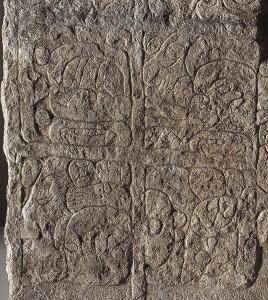
Glyphs
The hieroglyphic text forms a wall and ceiling around the figure, suggesting that he is standing inside a building. The Maya developed their own system of writing, which archeologists consider to be the most sophisticated ever developed in the Americas. The written language consists of hundreds of individual signs, called glyphs, which are paired in columns that read from left to right and top to bottom. The Maya writing system allowed room for artistic expression, so Maya glyphs are often quite elaborate. The first nine glyphs in this carving record the date; the tenth glyph is the verb; and the remaining thirteen glyphs describe the ruler. From the glyphs we know that the ruler was the master of a captive named Yax-ik’nal, and that he captured fourteen other prisoners, which suggests that he was very successful in battle. The glyphs also tell us that the ruler was at least 41 years old, and no older than 60, at the time the stela was made.
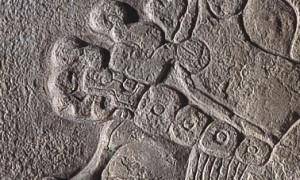
Jeweled Headband
The man in the monument can be identified as a ruler because he wears a jeweled headband around his forehead called a sac hunal, which means “resplendent one.” It is similar to a crown and would have been tied around the ruler’s head when he came to power. In the center of the headband is the head of a deity, which was usually carved in jade. The deity wears a long, three-pointed cap and is nicknamed the “jester god.”
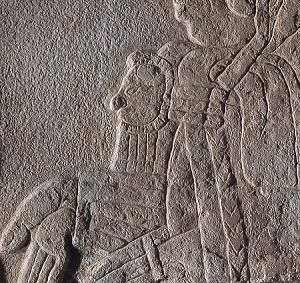
Ornaments
The ruler wears a jade ornament in the shape of a head on his chest. Long quetzal feathers decorated with jade beads fall down his back. Both of these ornaments are signs of his powerful status.
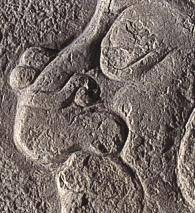
Distinctive Facial Markings
Notice the figure’s heavily lidded eye, the swirling line on his nose that could be a facial scar, and jade bead ornaments on his nose.
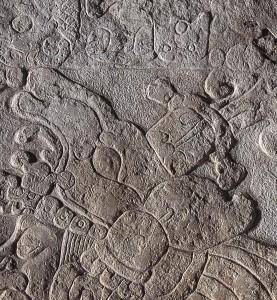
Headdress
On top of the ruler’s headband sits a jaguar head. Above that is the glyph ak’bal, which means “darkness.” Smoke or fire rises out of the ak’bal glyph.
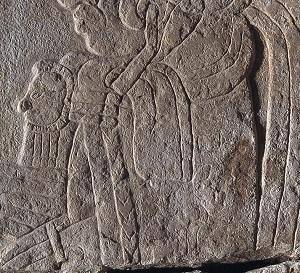
Clothing
The man wears a knotted scarf around his neck and a long cape decorated with three human eyes. Both of these are part of the special clothing the Maya wore when performing sacrificial rituals.

Incense Bag
In this ritual, the ruler is shown scattering incense. His left hand holds a long bag containing the incense, and his right hand is in the scattering gesture. At his feet is a large basket containing long strips of paper and a small tied bundle.

Empty Space
The empty space between the figure and the glyphs emphasizes the outline of the figure, particularly in the areas around his face and headdress.
Funding for object education resources provided by a grant from the Morgridge Family Foundation. Additional funding provided by the William Randolph Hearst Endowment for Education Programs, and Xcel Energy Foundation. We thank our colleagues at the University of Denver Morgridge College of Education.
The images on this page are intended for classroom use only and may not be reproduced for other reasons without the permission of the Denver Art Museum. This object may not currently be on display at the museum.







